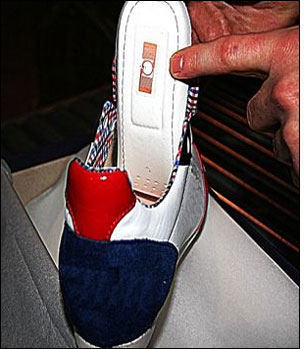Nov 04, 2010LTC-Logistics (LTC s.r.l.), an Italian third-party logistics firm that fulfills orders for fashion companies, has implemented an RFID reader infrastructure at its warehouse and fulfillment center in Florence, in order to track individual fashion items tagged by various producers whose goods move through its facilities.
The reader infrastructure became operational at the end of December 2009, Meredith Lamborn, a member of LTC's investigation group when the company launched its RFID project, told attendees today at RFID Journal LIVE! Europe 2010, held this week in Darmstadt, Germany. According to Lamborn, two of the company's clients are currently speeding up the distribution of their fashion items by taking advantage of that reader infrastructure.
LTC, which fulfills orders that include 10 million items each year, expects to process 400,000 RFID-tagged items in 2010 for Royal Trading s.r.l., which owns the Serafini brand of high-end men's and ladies footwear, and San Giuliano Ferragamo, with its Fashionis brand. Both companies are embedding EPC Gen 2 RFID tags into items, or tagging them with RFID hangtags at the point of production, in Italy.
In 2007, after LTC had already conducted initial tests of RFID technology, Royal Trading and LTC began discussing the use of RFID in LTC's warehouse. Royal Trading was in the process of developing a system to employ radio frequency identification for tracking inventory in stores that carry Serafini products. The footwear company wanted a better overview of its inventory in each store, Lamborn explained, and also wanted to prevent items from being lost or stolen, by verifying that goods arrived at the intended retail outlets.
LTC's IT department set up a portal reader with eight antennas, as well as a tunnel reader with four antennas, using Impinj Speedway interrogators. The portal reader is surrounded by a metal barrier, Lamborn said, that looks a bit like a cargo container, and that makes sure the portal reads only the tags of items passing through it, and not those attached to other apparel in the general vicinity. During the testing phase, she told the audience, the portal reader's antennas were adjusted for reading packed fashion items, and LTC now achieves 99.5 percent read rates.
"Accurate read rates are very important," Lamborn stated. "We are responsible for our clients´ products. We've got to have close to 100 percent."
When the goods arrive from their production point at LTC's facility, those that are RFID-tagged are sent to a particular unloading bay, and are then moved through the portal reader on pallets. Items not RFID-tagged are transported to other bays, where workers process those goods using scanners to read bar-coded labels attached to individual items within a particular box.
When client orders come in for RFID-tagged items, LTC picks the orders and packs the appropriate items into cartons that are then moved through the tunnel reader, located near outgoing shipping bays. By reading each item's RFID tag, the system identifies the goods, verifies they are accurately picked and prints out packing lists that are placed within the shipping box. LTC's information system is then updated to indicate that the items have been packed and are ready for shipment.

According to Lamborn, the tags are not being read by the retailer upon receipt of the goods. Royal Trading's personnel occasionally visit the stores, however, and use mobile RFID readers to take inventory of Serafini products. The clothing maker does this, she explained, in order to ensure that the retailers keep intended products in assigned stores.
According to Lamborn, LTC has reduced the time it takes employees to generate packing lists by 30 percent, thanks to the use of RFID. For the receiving process, she said, savings are significantly higher. The company now needs to employ only a single operator in receiving instead of five, and is able to process the same amount of goods in receiving in three minutes that it previously took 120 minutes to accommodate.
The project, which took two years to implement, included an extensive testing phase, during which LTC worked with fashion-item producers to determine the minimum quality level for tags, as well as the best positioning of those tags to achieve the highest read rates.
LTC invested €50,000 ($71,000) in RFID equipment for its warehouse, and expects to achieve a return on that investment in three years. The company plans to expand its use of the technology for picking and other processes within three to five years.



